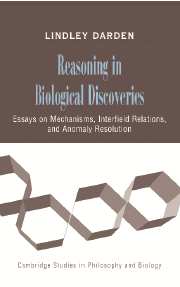 Reasoning in Biological Discoveries
Reasoning in Biological Discoveries Book contents
- Frontmatter
- Contents
- Long Contents
- List of Figures
- List of Tables
- Acknowledgments
- Introduction
- PART I BIOLOGICAL MECHANISMS
- PART II REASONING STRATEGIES: RELATING FIELDS, RESOLVING ANOMALIES
- 5 Interfield Theories with Nancy Maull
- 6 Theory Construction in Genetics
- 7 Relations Among Fields in the Evolutionary Synthesis
- 8 Selection Type Theories with Joseph A. Cain
- 9 Strategies for Anomaly Resolution: Diagnosis and Redesign
- 10 Exemplars, Abstractions, and Anomalies: Representations and Theory Change in Mendelian and Molecular Genetics
- 11 Strategies for Anomaly Resolution in the Case of Adaptive Mutation
- PART III DISCOVERING MECHANISMS: CONSTRUCTION, EVALUATION, REVISION
- Bibliography
- Index
- References
8 - Selection Type Theories with Joseph A. Cain
Published online by Cambridge University Press: 31 August 2009
- Frontmatter
- Contents
- Long Contents
- List of Figures
- List of Tables
- Acknowledgments
- Introduction
- PART I BIOLOGICAL MECHANISMS
- PART II REASONING STRATEGIES: RELATING FIELDS, RESOLVING ANOMALIES
- 5 Interfield Theories with Nancy Maull
- 6 Theory Construction in Genetics
- 7 Relations Among Fields in the Evolutionary Synthesis
- 8 Selection Type Theories with Joseph A. Cain
- 9 Strategies for Anomaly Resolution: Diagnosis and Redesign
- 10 Exemplars, Abstractions, and Anomalies: Representations and Theory Change in Mendelian and Molecular Genetics
- 11 Strategies for Anomaly Resolution in the Case of Adaptive Mutation
- PART III DISCOVERING MECHANISMS: CONSTRUCTION, EVALUATION, REVISION
- Bibliography
- Index
- References
Summary
INTRODUCTION
This chapter discusses abstract characterizations of selection theories. Finding such abstractions is a task in a larger research program, which is based on the assumption that some scientific theories are representative of types of theories that solve types of problems. Natural selection, clonal selection for antibody production, and selective theories of higher brain function are examples of selection type theories. Selection theories solve adaptation problems by specifying a process through which one thing comes to be adapted to another thing.
When Darwin elaborated his theory of natural selection in 1859, he provided a new type of theory for explaining adaptation problems. Others, such as Burnet (1957) in immunology, argued by analogy from Darwinian natural selection for selection processes in other fields. One analysis of analogy is that two analogues share a common abstraction (Genesereth 1980). Thus, an analysis of natural selection and its analogues aids in the development of an abstraction for selection theories. The selection literature in philosophy of biology includes several discussions of natural selection that provide help in this task. The abstraction for natural selection extracted from these discussions will then be used in analyzing clonal selection for antibody production in immunology and selective theories for higher brain function in neurobiology. Before beginning the analysis of selection theories, however, we will briefly discuss the concept of an abstraction.
THE CONCEPT OF AN ABSTRACTION
An abstraction provides a schematic outline that can be filled in or “instantiated” to give an actual theory.
- Type
- Chapter
- Information
- Reasoning in Biological DiscoveriesEssays on Mechanisms, Interfield Relations, and Anomaly Resolution, pp. 182 - 206Publisher: Cambridge University PressPrint publication year: 2006


